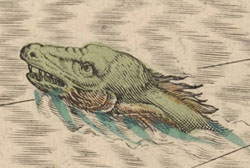Lesson Plan - Ghosts and Sea Monsters: Analyzing Mythology
A Lesson Plan for Grades 9-10 Language Arts
By Jennifer Job, School of Education, UNC-Chapel Hill
This lesson is meant to accompany a ninth or tenth grade unit covering myths and legends. Students will analyze sea creatures found in 16th and 17th century maps in terms of culture and context. They will then search for stories relating to North Carolina legends, ending by writing a story of their own.
Time Required: Two 50-minute class periods (plus homework)
Materials and Resources:
- Computer lab with Internet access
Teacher Instructions:
- Begin with a brief overview of mythology in the context of the literature you will be studying. Discuss the elements of mythology, such as archetype, mystical creatures, and cultural context.
- Assign each student a tale to read from the following Web site: http://www.coastalguide.com/tales/. These are myths about the coast and waters of North and South Carolina. Ask the students to share these stories aloud; reinforce the idea that myths were passed down orally and were meant to be shared by telling, not writing.
- Lead a class discussion about the tales they have read and heard. Ask the students to name elements that the stories have in common (e.g., a ghost or mystical being, a person who interacts with the being, a dangerous situation). Ask them how the stories are constructed—what they see in common with the beginning, middle, and end of each story. Then discuss what the purpose of the stories are. They should come to the conclusion that these myths are meant to explain an occurrence or natural phenomenon that otherwise cannot be explained. (If you are working with sophomores, remind them about the Greek myths they read last year and allude to the fact that they will soon read Creation Myths that explain the beginning of the world.)
- Ask students to share some myths that we still tell today (e.g., Loch Ness Monster, Big Foot, alien abductions).
- As an introduction to the map portion of the lesson, explain to students that in early exploration (15th-18th centuries), ships were often lost at sea, never to be heard from again. Ask what explanations people of the time may have thought of. Also, ask what explorers may have thought of the sea creatures they caught glimpses of during their travels, such as the octopus or the whale.
- Direct students to the North Carolina Maps site (http://www.lib.unc.edu/dc/ncmaps/). Ask them to explore the maps dating between 1500 and 1699. They should find five examples of sea monsters on at least three different maps. Have them document:
- The map title and date
- An approximate location of the monster
- A detailed description of the monster
- Americae pars, Nunc Virginia (1590)
- Bottom left corner
- There is a picture of a mermaid. She has wings and flippers instead of arms, and short curly hair. Her bottom is the tail of a fish, long and curved, with a skirt around her middle.
- Finally, ask students to choose one of their sea monsters and write a 1-2 page myth with it as a character. The story should include all of the elements of mythology that you have discussed, and the story should explain either a natural phenomenon or an event that happened (real or imagined).
Assessment: You may have the students share their stories with a partner (it is often intimidating to share creative writing with the whole class) and ask the partner to evaluate whether all of the elements are present, or you may wish to collect the examples and stories.
North Carolina Curriculum Alignment
1.02: Respond reflectively (through small group discussion, class discussion, journal entry, essay, letter, dialogue) to written and visual texts by:
- relating personal knowledge to textual information or class discussion.
- showing an awareness of one's own culture as well as the cultures of others.
- exhibiting an awareness of culture in which text is set or in which text was written.
- explaining how culture affects personal responses.
3.04: Demonstrate the ability to read, listen to and view a variety of increasingly complex print and non-print argumentative texts appropriate to grade level and course literary focus, by:
- identifying and analyzing text components (such as organizational structures, story elements, organizational features) and evaluating their impact on the text.
- providing textual evidence to support understanding of and reader's response to text.
- summarizing key events and/or points from text.
- making inferences, predicting, and drawing conclusions based on text.
- identifying and analyzing personal, social, historical or cultural influences, contexts, or biases.
- making connections between works, self and related topics.
5.02: Demonstrate increasing comprehension and ability to respond personally to texts by:
- selecting and exploring a wide range of works which relate to an issue, author, or theme of world literature.
- documenting the reading of student-chosen works.

